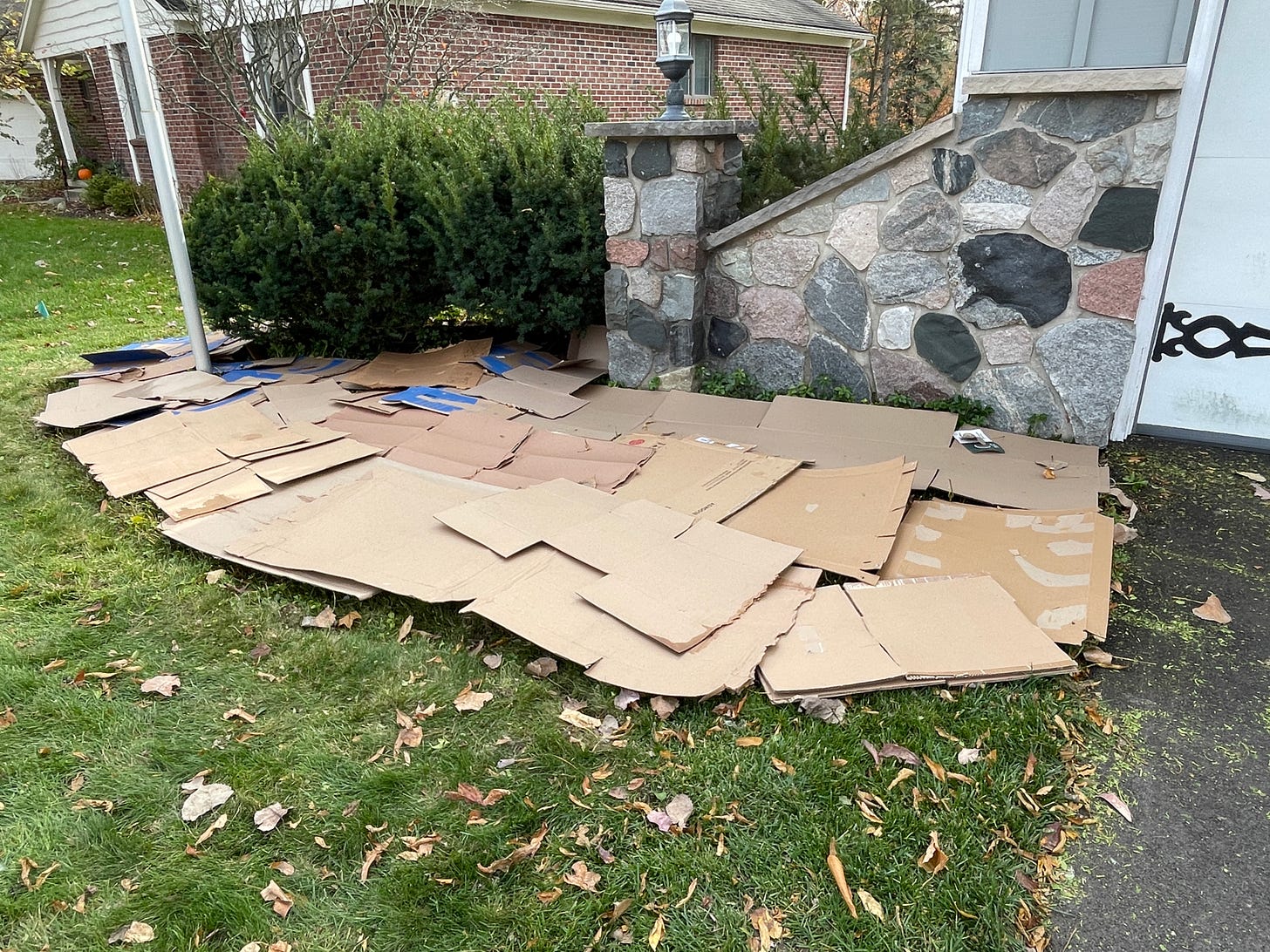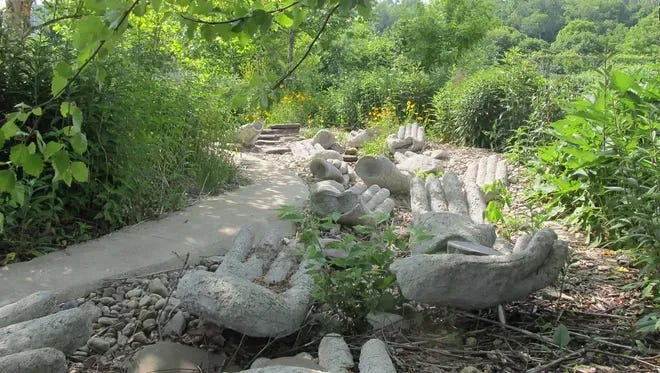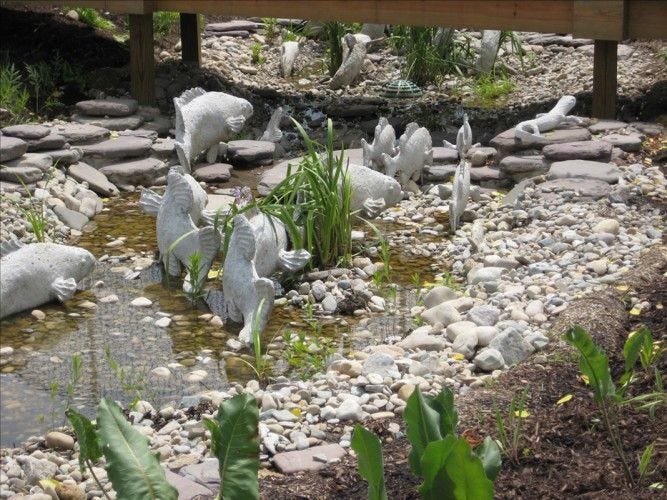Refugia News
I told my students this week that if the semester is a marathon, we have reached mile 17. They are so tired, but they have to just…. keep….. going. And we will. Not that I know anything about what it’s like to run a marathon. But you know, you hear things. And I’m good at metaphors.
Amid cheering up tired students and trying frantically to do fall yard work, I have a few fun Refugia Faith-related gigs coming up, including two visits to area churches, an online webinar, and two podcast recordings. I’ll let you know, of course, when the webinar and podcast episodes drop. I’ve mentioned before that I’ve been lucky enough to participate in the Green Lectionary Podcast sponsored by Creation Justice Ministries. We’re recording an episode next week where a few of us are going to discuss Mark 13:24-37. That’s the whole “sun will be darkened” but “no one knows the day or the hour” passage. I mean, what is Jesus trying to tell us while in this weird apocalyptic mode? Yikes. Well, I guess the other guests and I will try to pool our scholarly knowledge and puzzle it out together.
Have you ever used the cardboard method? You cover the area you want to plant with cardboard, wet it down, add a layer of mulch, then compost, then more mulch and: ta da! Next spring we can plant this area with native plants! Underneath is a pachysandra bed that we mowed down to the ground. I like pachysandra, but I like native flowers and grasses more. No doubt the pachysandra will attempt a rebirth.
Before getting into this week’s topics, I want to offer an official shout-out and a big thank you to reader Sid Sybenga, whose referrals yielded four new subscribers to the Refugia Newsletter. Thanks so much for your support, Sid! And welcome new subscribers.
Please help build our community by referring to your friends, too. It’s free!
This Week in Climate News
In the last few weeks, I’ve gathered quite a few articles about solar power, so we’re going to do an all-solar issue in which we pretty much roll the News and Deeper Dive features together into one continuous update on the topic of “What’s happening with solar?”
First, let’s put this in context. Right now, the fossil fuel industry is busy expanding its capacity to drill and frack and ship and otherwise continue to make climate change worse. The U.S. is plenty guilty of aiding and abetting this. From Bill McKibben’s newsletter:
As Oil Change International said in a landmark September report, the US is responsible for more than a third of planned fossil fuel expansion around the world between now and 2030, far more than any other country. We are, [the report] concluded, the “Planet Wrecker in Chief.” (The other biggest troublemakers include Canada, Norway, and Australia, which is to say rich well-educated countries that can find plenty of other ways to make a living).
Bill McKibben in the last few weeks has been arguing emphatically that the US has to stop exporting natural gas. Here’s his recent article on this in The New Yorker.
We could go down that deep, dark, rabbit hole, but not this week. Instead, we’re going to balance ominous ponderings with some good news and consider a recent New York Times series on how "The Clean Energy Future is Arriving Faster Than You Think.”
You might be old enough to remember the old mantra about running a political campaign in America: “It’s the economy, stupid.” The idea is that you can yammer on all you want about other issues, but Americans vote based on how the economy is doing. Whether or not that’s true, that bon mot could be applied to what’s happening with solar (and wind) energy in the U.S.:
The cost of generating electricity from the sun and wind is falling fast and in many areas is now cheaper than gas, oil or coal. Private investment is flooding into companies that are jockeying for advantage in emerging green industries.
The article features a guy in Tulsa, Oklahoma—fossil fuel central—who gave up his contracting business in order to start a solar installation business. Why? Because he loves the polar bears? Well, he said, “The environmental benefits are nice … but most people are doing this for the financial opportunity.”
This is not just in the U.S., either:
In May, for the first time ever, wind and solar power in the E.U. generated more electricity than fossil fuels. And in China, which is currently both the world’s top polluter and the global leader for renewable power, the government continues to invest in every stage of clean energy production, from solar cells to batteries, wind turbines and more. Like the United States, China provides subsidies to buyers of electric vehicles. Last year it spent $546 billion on clean energy, far more than any other country in the world.
And thus you have a wildly steep graph showing the increase in amount of electricity generated by solar and wind since 2010.
The New York Times reporting was spread across a three-part series, and the second two parts outlined some obstacles to a rapid buildout. These include supply chain issues, the need for far more workers and electricians, power grid issues, permitting tangles, and of course, NIMBY—”not in my backyard.” That is, people are happy to have new energy infrastructure built—as long as it’s not near them.
Still, Zahra Biabani pointed in her newsletter to an article in Reuters describing how people in the US and the EU increasingly want investment in renewables. Biabani summarizes:
Another study conducted by the Golcalities showed that through May and June, the EU and the United States were 85% in support of investment into renewable energies. This is a 16% jump from a Pew Research Center poll in early 2022, of which there was only a 69% show of agreement. As both energy demands and global warming increase, this approval for renewable energy is encouraging.
It’s a race, of course. How fast can we shift to renewables? And can we do it fast enough to outpace not only, well, atmospheric physics, but also the foot-dragging (and meantime cash-grabbing) of the fossil fuel industry? The International Energy Agency released a report in October suggesting that we could reach “peak oil” before the end of this decade, but there’s a however. As the New York Times reported:
Cleaner energy technologies like electric cars and solar panels are spreading so rapidly that the global use of oil, coal and natural gas could peak this decade, but countries will still need to pursue more aggressive measures if they want to limit global warming to relatively safe levels, the world’s leading energy agency said Tuesday.
Meanwhile, the economics for the fossil fuel industry are, of course, rather different than they are for you and me:
Exxon is flush with cash and a record high stock price. But instead of investing in clean energy, it is choosing to produce more oil and gas. The ruthless logic of the marketplace is pushing Exxon and other big oil companies to double down on fossil fuels instead of investing in green technologies.
Deeper Dive
Back to solar energy, specifically. I’ve been gathering some articles that address common challenges with, or objections to, solar power. Let’s look at a few.
What about land use? Don’t solar farms require tons of land?
As usual, Hannah Ritchie has done some math. She wondered: What about all that land the US now uses to grow grains for biofuel?
The US uses a UK-sized amount of land to grow biofuels. In return, [biofuel] accounts for around 10% of the country’s motor gasoline supply. It accounts for a lower share of total transport fuels (including jet fuels etc.).
So if we took that much land and instead used it for solar farms, what would be the return in terms of power generated? “Putting solar panels on biofuel land would … power the US three times over.”
She is quick to add:
Of course, I’m not advocating this as an actual strategy, for several reasons. The US would need huge amounts of storage if it were to rely on solar power alone. And solar should be prioritised on roofs, car parks etc. before being put on other land.
Roofs and car parks! Of course, this is already happening.
In fact, people are putting solar on their rooftops at an accelerating pace. Why? You guessed it: because they want to save money, especially with rising utility rates.
How about parking lots? Yep. Here’s a nifty video made by Vox explaining the benefits of putting solar in parking lots and on the roofs of big-box stores, etc.
Neato! But…
What about recycling those panels? Doesn’t this industry just create more waste? And aren’t solar panels toxic?
Dan Gearino of Inside Climate News has you covered on these concerns. In short, the amount of waste is marginal compared to say, municipal waste, coal ash, or plastic. And worries about health dangers are completely unfounded.
Moreover, people are working on a recycling industry for solar panels. It’s not simple, but it can be done, as outlined in this article by Emma Peterson and Wyatt Myskow, also in Inside Climate News.
OK, but what about the grid? Is our grid ready for all this solar and wind?
Ah, now that’s a great question. And complicated. Here I can only recommend two fabulous episodes of the Volts podcast—that place I go to satisfy my inexplicable need to get into the wonky weeds on electrification.
Try the episodes called “Getting more out of the grid we’ve already built” (Sept. 13) and “What? The sun isn’t always shining?” (Nov. 1). Spoiler alert: we have the technology already. And of course, solar is only one key part of a mix of renewable sources—a mix that will differ from region to region.
Now: we still need to talk about mining. The rare metals issue is an important one. But let’s leave it for another time, shall we?
Meanwhile, if you are ready to harness the sun’s glorious power on your own rooftop—or at your church or faith community!—here are some quick links to resources. For residential solar, try the US Department of Energy’s Homeowner’s Guide and the Inflation Reduction Act explainer at ReWiring America. For faith communities, Interfaith Power and Light has you covered. Check out their information page about benefits in the IRA for faith communities.
Refugia Sighting
I always love seeing artists get involved in climate resilience and restoration projects. Here’s an inspiring story about eco-artist Jackie Brookner, who died in 2015. Brookner was involved in a river restoration project in Cincinnati, which I read about in an article by Louise Conner, Editor of the EcoDisciple Newsletter from Circlewood, some refugia-savvy friends out in Washington state.
Decades of waste and runoff from pork and soap industries left Mill Creek horrendously polluted, with dangerously high E. coli loads. Since Mill Creek runs into the Ohio River, polluted water gets carried through many communities. So activists and organizers founded the Mill Creek Restoration Project and set out to heal the creek and restore riparian ecosystems. One part of their work has been the development of Salway Park, a beautiful public space meant to model “sustainable urban stormwater practices.”
Part of “Laughing Brook,” by Jackie Brookner. Image credit: jackiebrookner.com
That’s where Jackie Brookner came in, with 106 sculptures forming an overall work titled "Laughing Brook":
Her biosculptures started as hand-crafted stone figures which became a base for photosynthetic plants, moss, vertebrates and invertebrates, creating ecosystems in which nutrients are cycled and exchanged among the ecosystem's organisms. These created ecosystems act as natural water purification systems. Brookner’s website states that the intent of the sculptures is “to seed a sense of connection to worlds beyond the human and to encourage understanding that is it possible to sustain human life in ways that benefit natural systems, rather than degrade them.”
The park stores runoff from parking lots and playing fields in a cistern, then releases the water through the park and into a wetland area before it enters Mill Creek, filtering the water along the way. To help people enjoy the park, “Walkways meander over the wetland stream and biosculptures, surrounded by prairie landscapes, butterfly gardens and native plant nurseries.”
I love these whimsical and practical sculptured fishies. Image credit: jackiebrookner.com
And guess what: “Turtles, salamanders, beavers, and birds have all returned to the Mill Creek corridor.” The place is now a birding hotspot—a refugium.
You can learn more about the project on Brookner’s website.
The Wayback Machine
Just a not-so-wayback this time. If you want to read a longer analysis of the recent PRRI study on religion and climate in the US, I invite you to take a look at my recent blog post on the Reformed Journal blog: “Religion, the Climate Crisis, and Faith Formation.”
Till next time, be well.








